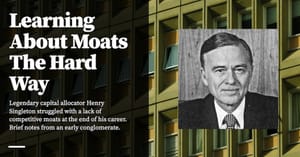What a puzzle from Charlie Munger tells us about a supply-side business model with unreasonably high returns.
In late 2003, Charlie Munger gave the Herb Kay Undergraduate Lecture at the University of California, Santa Barbara. I remember reading the text of the lecture as a university student, some seven or eight years after Munger first delivered it, stretched out on my dorm bed, attempting to clear my ‘read-later’ list.
The title of the lecture was ‘Academic Economics: Strengths and Faults After Considering Interdisciplinary Needs’ (full transcript available here). In it, Munger does what Munger does best: he takes potshots at mainstream economics thinking, airing a list of grievances in his grumpy grandfatherly way.
One part of the speech stood out to me, even then. Munger opens with the following story (all emphasis mine):
My fifth criticism is there is too little synthesis in economics. Not only with matter outside traditional economics, but also within economics. I have posed at two different business schools the following problem. I say, “You have studied supply and demand curves. You have learned that when you raise the price, ordinarily the volume you can sell goes down, and when you reduce the price, the volume you can sell goes up. Is that right? That’s what you’ve learned?” They all nod yes. And I say, “Now tell me several instances when, if you want the physical volume to go up, the correct answer is to increase the price?” And there’s this long and ghastly pause. And finally, in each of the two business schools in which I’ve tried this, maybe one person in fifty could name one instance. They come up with the idea that occasionally a higher price acts as a rough indicator of quality and thereby increases sales volumes.
This happened in the case of my friend Bill Ballhaus. When he was head of Beckman Instruments it produced some complicated product where if it failed it caused enormous damage to the purchaser. It wasn’t a pump at the bottom of an oil well, but that’s a good mental example. And he realized that the reason this thing was selling so poorly, even though it was better than anybody else’s product, was because it was priced lower. It made people think it was a low quality gizmo. So he raised the price by 20% or so and the volume went way up.
But only one in fifty can come up with this sole instance in a modern business school — one of the business schools being Stanford, which is hard to get into. And nobody has yet come up with the main answer that I like. Suppose you raise that price, and use the extra money to bribe the other guy’s purchasing agent? (Laughter). Is that going to work? And are there functional equivalents in economics — microeconomics — of raising the price and using the extra sales proceeds to drive sales higher? And of course there are zillion, once you’ve made that mental jump. It’s so simple.
One of the most extreme examples is in the investment management field. Suppose you’re the manager of a mutual fund, and you want to sell more. People commonly come to the following answer: You raise the commissions, which of course reduces the number of units of real investments delivered to the ultimate buyer, so you’re increasing the price per unit of real investment that you’re selling the ultimate customer. And you’re using that extra commission to bribe the customer’s purchasing agent. You’re bribing the broker to betray his client and put the client’s money into the high-commission product. This has worked to produce at least a trillion dollars of mutual fund sales.
This tactic is not an attractive part of human nature, and I want to tell you that I pretty completely avoided it in my life. I don’t think it’s necessary to spend your life selling what you would never buy. Even though it’s legal, I don’t think it’s a good idea. But you shouldn’t accept all my notions because you’ll risk becoming unemployable. You shouldn’t take my notions unless you’re willing to risk being unemployable by all but a few.
I think my experience with my simple question is an example of how little synthesis people get, even in advanced academic settings, considering economic questions. Obvious questions, with such obvious answers. Yet people take four courses in economics, go to business school, have all these IQ points and write all these essays, but they can’t synthesize worth a damn.
Munger, of course, goes on for a bit more, making fun of these poor academicians who aren’t trained to do practical synthesis, before shifting his attention to yet another failing of economics. But the story he told of those business students lingered, if only because my mind went “ooh, luxury goods” almost immediately, and then I felt good after reading that “only one in fifty can come up with that one instance.” That puts me in the same class as a Stanford business student I thought, pleased with myself.
And so I did not think to ask a relatively obvious question.
Why was Munger interested in this model of supply demand dynamics? Sure, he gave it as an example of practical synthesis — a type of intelligent ‘grabbing across multiple disciplines’ that he is so known for. Plus he used the opportunity to lecture on the ethics of this sort of business model — particularly in his own industry of investment management. But why was he interested in that synthesis in the first place?
The obvious answer here is that Munger is an investor; investors are interested in identifying good businesses to sock more money in … which means that Munger was interested in this synthesis because it is yet another pattern of a high return business, one that he may use. The agency problem results in businesses setting higher prices at higher volumes than they otherwise would be able to. Isn’t that an interesting condition for a business to find itself in?
Unlike me, Marathon Asset Management recognised Munger’s insight for what it was … and then went hunting for such businesses. They dedicate an entire section in Capital Returns to this idea, which they nickname ‘the agency business model.’ They point out that this is actually a form of supply side analysis: you identify a particular structure of market supply, one that is atypical and that more often than not leads to supernormal returns. And then they take you by the hand and walk you through a number of examples, across a surprising array of industries.
Originally published , last updated .
This article is part of the Market topic cluster, which belongs to the Business Expertise Triad. Read more from this topic here→





